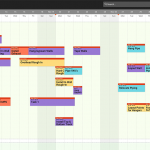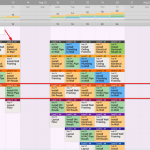( By Hal Macomber and George Hunt, Lead – Pre-Sales/Sales Engineering Touchplan) Today we’ll show you how to develop a takt plan for non-repetitive work. (Repetitive work has more challenges.)
We use a typical pattern that gathers information about the sequence of operations, durations, crew sizes, and batch size.
Sequence the Work to Understand the Range of Trade Capabilities
We start by learning what it will take to meet the milestone for a particular phase of work. It will be different for different trades. We design the initial planning to uncover the obstacles to achieving flow.
- Identify the milestone conditions of satisfaction — doneness criteria — for the area or location of the work. This area or location should be one of the non-recurring spaces on the project (i.e. lobby, common space)
- Start from the intended completion date and work backward as we do with pull plans.
- For every operation, have the trade partners identify on a work ticket
- The specific process they will perform
- The smallest crew size that is reasonable
- The minimum duration they need for the operation (smaller is better)
You now have a description of the flow of work and the range of crew sizes and durations the trade partners think they need.

Now, Establish a Takt and Scale Capacities
- Find the smallest crew that can complete the most work in the least amount of time or the operation that will be the bottleneck for the area.
- Scale the other crews to match the takt (pace) of the fastest smallest crew or bottleneck.
Undoubtedly, when you scale up, you won’t get round numbers. A trade that needed just under three people to do work in two days may need 5.33 people to do it in one day. Taking longer doesn’t meet takt. Rounding up capacity makes the trade less productive. Neither is acceptable. So, what do we do?

Balance and Buffer the Work
- Find the imbalances. The rule of thumb is to round up the capacity. However, you could look for an improvement that would unload the onsite work to prefabrication, kitting, or operations improvements to reduce the capacity requirements to meet the pace.
- Identify workable backlog (ready but not currently needed work that won’t create problems for other trades when performed early) for partial crew members to work on while others complete the takt period’s work.
You now have the plan for one non-repeating flow unit that will maintain flow without negatively impacting trade partner productivity.
Install Practices to Maintain Control
Life is what happens to you while you’re busy making other plans.
John Lennon, Beautiful Boy, quoting Allen Sanders, Readers Digest, 1957
Takt requires commitments from all trade partners to their “customers,” other trade partners who follow their work, to get the job done in the established takt. There’s no learning curve on an operation-by-operation basis for non-repetitive work. Get it done, else the following trade may have no place to work. Making work ready and managing your promises are the essential practices for achieving and sustaining flow.
We make work ready when we remove all the roadblocks to starting and finishing work as promised. That includes have the resources — tools, equipment, material, skilled team members, and safe working conditions — to perform the work as planned. Still, life — unexpected circumstances and variation — will appear.
So, have an end-of-day stand-up meeting among the last planners (usually foremen) for the operations underway. At that meeting the last planners report complete to their “customers.” They recommit to their following promises. They ask for help and offer help to keep the flow going. And when that is not possible, they replan the work.
Takt Is a Journey of Learning
There are a few keys to succeeding with takt.
- Follow the four production laws.
- Status the work on a timely basis.
- Take care of your “customer” while you take care of yourself.
- Use performance data to improve your planning practices.
- Embrace a mood for learning.
Takt looks like an advanced practice for some people. It’s been around for almost 100 years. While CPM got the attention of the industry rather than takt, there is no better way to design production consistent with production laws than to use takt. And use the Last Planner System of Production Control® to pull it together as a coherent system.
You can contact George at [email protected] to learn more about how Touchplan helps teams successfully embrace takt planning and control. If you missed last week’s post be sure to read, Pace Construction to Bring Sanity to Your Construction Project.










